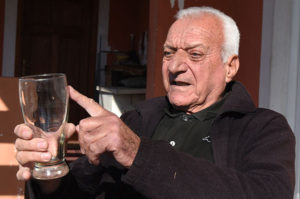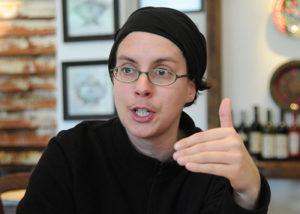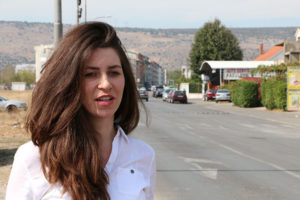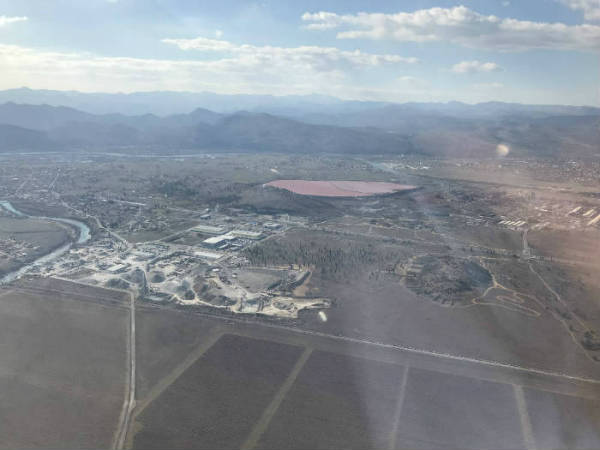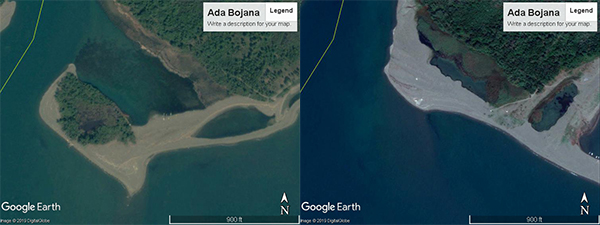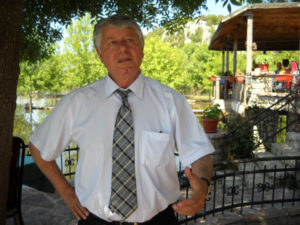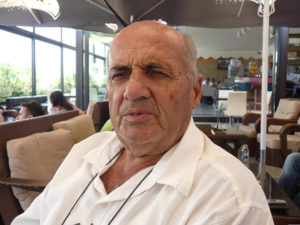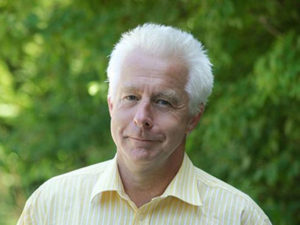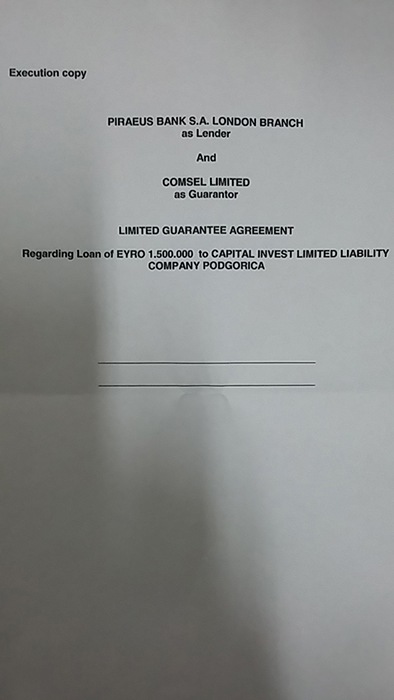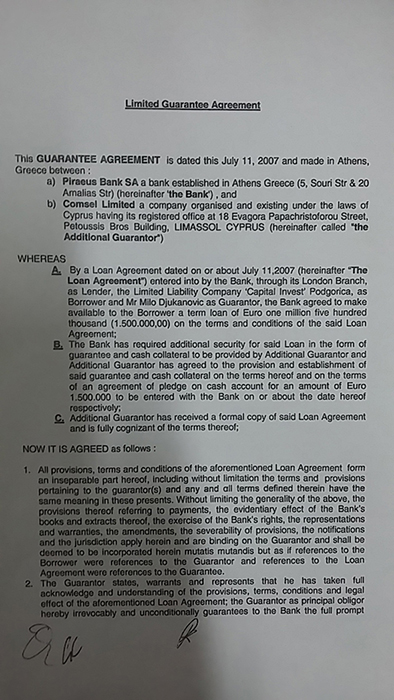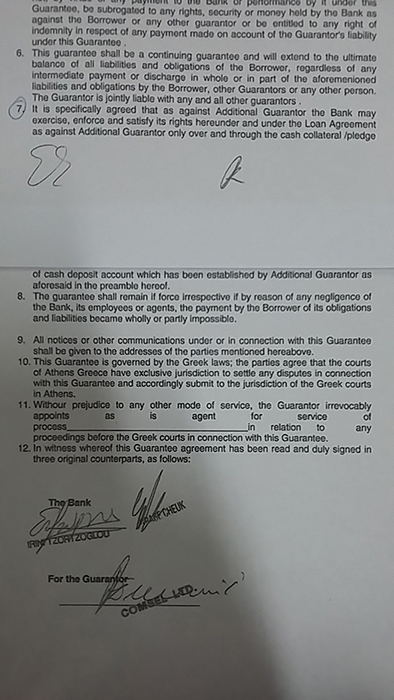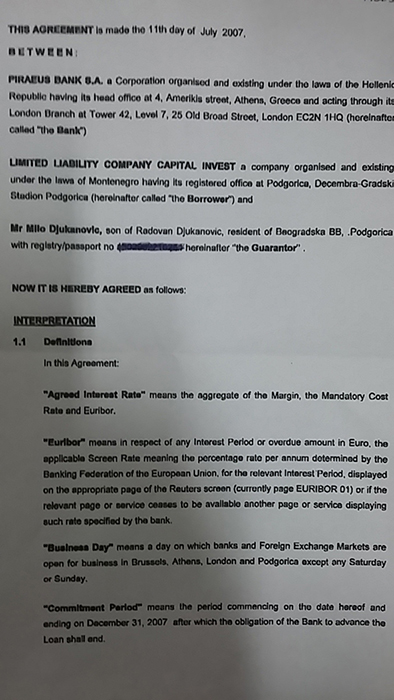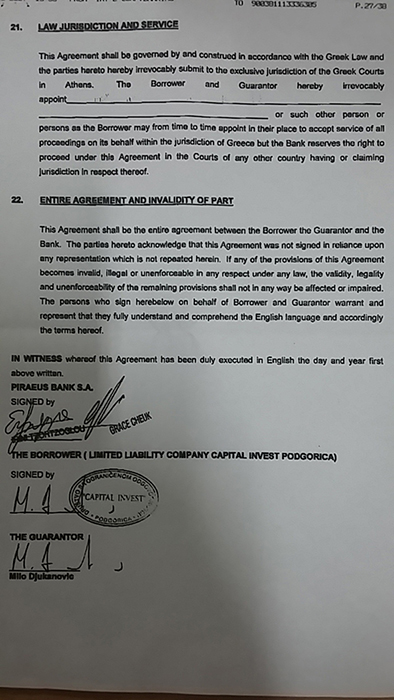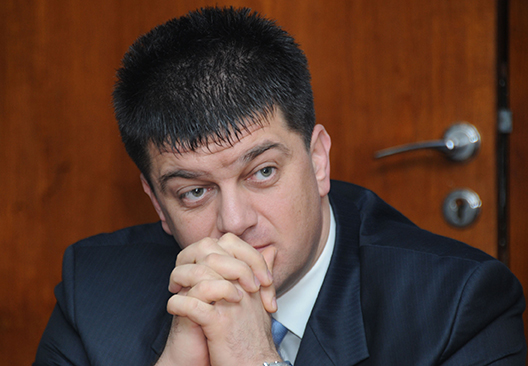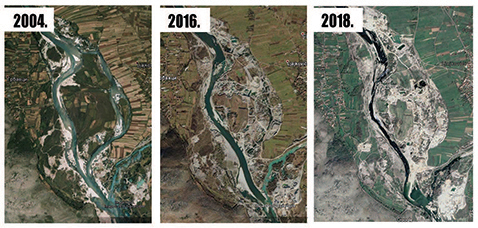As funds granted by the World Bank remain unused the government is unmoved by some 7.5 million tonnes of hazardous waste that loom over the country. On the other hand the authorities' response to environmental incidents is merely symbolic whereas ordinary people have to bear the brunt of enormous environmental damage. The Brussels administration is not delighted with the Montenegrin government’s request to postpone tackling ecological problems caused by the aluminum smelter (KAP) for year 2030.
”There’s no future here in the next thousand or so years. The pollution is unbelievable. We can’t drink water here, we can’t grow plants, the underground water courses have been poisoned for 45 years” says Drago Terzic, a resident of Srpska, a village in close proximity to the aluminum plant and its red mud pools. The place is also plagued by piles of garbage and abandoned houses only 9km away from the centre of Montenegro's capital Podgorica. The Aluminum facility was once the prime giant of socialist industry. Its heyday passed long time ago but the consequences remain and are highly visible.
The Bauxite tailings are easily accessible. There is neither security around the place nor warning signs. Two red mud ponds which store around 7.5 million tonnes of hazardous waste are situated next to the smelter. One pond has non-permeable bottom while the other has no leaking barrier thus heavy metals and carcinogens penetrate and poison the underground and the surface waters alike.
Drago Terzic and his first neighbour Boro Lazovic complain that whenever a stronger wind descends it lifts the dust from the ponds and carries it around. They shut themselves in their homes and wait for the wind to cease. They point out that a part of the Moraca River is totally contaminated and without fish.
Dijana Milev Cavor of Green Home NGO warns of the red mud dangers to the environment. Green Home conducted a research on Lake Skadar and its pollution in 2012. The main source of contamination is KAP. The research further states that KAP has generated some 325 thousand tonnes of solid waste which is labeled as hazardous due to high concentration of fluorides, nickel, chromium, copper, cadmium, zinc, arsenic, mercury, cyanide... which have penetrated the soil and underground water courses.
The bauxite residue in its dry form can become airborne by wind and spread over large areas. It can pose a threat to arable land and to human health.
Moreover the Centre for Eco-toxicological Research (CETI) has warned for years about soil and underground water pollution around KAP. The Montenegrin Investigative Reporting Centre's (CIN-CG) findings prove once more that the authorities’ response has been inadequate.
The World Bank granted a loan of €50 million five years ago to solve the problem of KAP’s bauxite tailings and solid waste. However, the project is stuck from the very beginning.
Montenegro’s request to postpone implementation of the EU ecological standards for 11 years is something unheard of so far- Gallop
The deadline for issuing Integrated Pollution Prevention and Control (IPPC) permit to KAP smelter expired on 1 Jan 2018. IPCC permits are one of the conditions for Montenegro-EU accession talks as thereby industrial facilities prove that they adhere to the best techniques of pollution prevention and control.
The Montenegrin authorities are totally unprepared for the said criteria hence they keep trying to obtain concessions from the Brussels administration and push the deadline all the way up to 2030. In the meantime the IPCC implementation has been formally halted under excuse of unresolved property disputes between KAP’s bankruptcy administration and the new Niksic-based owner Uniprom LLC.
The Brussels administration replied our inquiry via Delegation of the EU to Montenegro saying that Montenegro could not change rules and policies of the EU. The European Commission said that Montenegro’s request to postpone the implementation of the IPCC Directive would require “a detailed elaboration before the EU reaches decision (by consensus of all member states)”. Until then Montenegro is expected to comply with and implement the current regulation including the aforesaid directive. “The European Union does acknowledge that Montenegro plans to adopt certain implementation plans in 2019 which are related to the said directive. That is a prerequisite to continue business in the interim periods” says Brussels.
The Ministry of Sustainable Development and Tourism (MORT) told CIN-CG that it requested an interim period in regard to implementation of the IPPC Directive on industrial emissions. MORT cites the examples of other candidate states which lodged similar requests during their accession talks.
An EU expert and an environmentalist of England-based Bankwatch Pippa Gallop says in the interview with CIN-CG that it is entirely unacceptable to postpone the directive implementation till 2030. The standards are relatively high hence no guarantee that Montenegro’s request will be granted.
“I know that Croatia requested to postpone the directive implementation for a couple of years but the Montenegrin request is something unheard of and I see no grounds for such a motion” says Gallop.
Speaking of the World Bank loan she says it’s surprising how little has been done to resolve the issue of the red mud ponds. The plans are frequently changed and the WB evades talking about it.
"On the other hand, the conditions to unlock the loan have not been met while the bank is in no hurry. However, for human and environmental reasons the present situation is unacceptable and we’ll keep pressing them about it” said Gallop
Pollution is "being investigated"
Montenegrin prosecutors in the meantime say they investigate last September and October incidents when the bauxite dust took off from the red mud ponds and contaminated the surrounding area. That was not the first time though. The Podgorica Prosecution Office confirmed to CIN-CG that Environmental Inspectorate and nearby residents lodged complaints “which are being investigated”.
Berane-based company Wag–Kolektor has been the owner of the red mud ponds since Feb 2016. Inspectors asked the company to install a system for sprinkling along the edge of the ponds since the area was not completely covered by irrigation system. The inspectors warned that the present provisions were insufficient to prevent emissions of red dust.
Sinisa Jevric, one of the founders of Wag–Kolektor, in the interview with CIN-CG states that all requests of the inspectorate will be fulfilled by the middle of the year.
On the other hand, the fines for non-compliance are rather jokes. Last October the aforesaid company was fined €300 while the owner nearly got away- he has to pay no more than €30.
The inspectors also investigate whether caustic soda leaked from the aluminum smelter into the Moraca River. However, it has been established that a certain amount of lye ended up in the smelter's sewage system. No good news arrive from there.
Any stronger earthquake could cause red mud to spill
Ana Misurovic, a former CETI executive and a toxicological expert, wrote in 2004 that people living around the aluminum smelter were risking their health by exposure to intoxicants in air, water and food...
The collapse of a dam on much larger bauxite tailings in northern Hungary 9 years ago caused the death of 9 persons while hundreds were injured and a large surrounding area was contaminated.
Misurovic in her interview with CIN-CG reckons that in case of a strong earthquake the red mud could spill out of the basins. She believes that no one has examined the potential threat so far.
Soil and underground waters around KAP were examined by CETI before. CIN-CG obtained CETI’s reports for 2016 and 2017 which stated that no improvement had been made. Physical and chemical analysis made in 2016 confirmed the presence of nitrates, zinc, cyanide, orthophosphate and ammonium above the red line levels in the underground water courses within the smelter's boundary.
CETI also analised the soil around KAP in those years and each report warn about increasing levels of chromium, nickel, fluorine, polycyclic aromatic hydrocarbons...
Environmental Protection Agency came up with similar findings in 2017 and blamed the aluminum smelter for the pollution.
Fishy transactions with red mud basins
OZON NGO director Aleksandar Perovic finds the authorities’ silence on pollution unacceptable and “possibly fatal to the population around KAP smelter”. Perovic criticises the whole thing about the loan granted by the World Bank as nothing has changed in reality. He lists the red mud basins as another example of botched privatisation.
“It made no sense to separate the bauxite tailings, a notorious black spot, from KAP smelter and hand it over to someone else”. The first company which took over the red mud basins had plans to extract the material which could be used in road constructions. “Unfortunately, the investor could not obtain the permits and left. Then the place ended up, under murky circumstances, in the hands of a company which was without any experience in the aforesaid business” says Perovic.
He further claims that it’s a public secret that the only aim of the privatisation is to resell the bauxite tailings to the government so that it becomes a part of KAP again. Thus everyone with fingers in the pie will his handy commission. Perovic is adamant that “the company (Wag-Kolektor) is not capable, both financially and in terms of expertise, to operate the red mud basins”.
However, Wag-Kolektor told CIN-CG that they had plans to restart the red mud procession together with its German partner by the middle of this year. Jevric denied that he had intention to sell the ponds to anyone. Nonetheless he did confirm that he was summoned by a local prosecutor to give a statement about the red dust emission at the end of last year.
MORT- standards must be adhered to regardless of permits
In the 2017 review the government states that KAP’s technology is outdated and incapable of implementing the EU standards in less then 10 years.
“ The issue of KAP is a very complex one. It’s not only a question of environmental and security risks but it comes together with the current bankruptcy protocol, ownership over bauxite tailings so to meet all the criteria set forth by the World Bank...” is stated by MORT.
Polluters to be held accountable
Uniprom hasn’t replied CIN-CG questions on the company’s vision in regard to environmental issues caused by the smelter’s operations and whether and when the company will apply for intergrated permit.
The government recently drafted a bill on industrial emissions which will introduce a new rule- “the polluters shall pay”. The fines will range from €5,000 to €40,000 for legal entities if they operate without permits or if they fail to submit anual reports on the quality of soil, air, water, sea etc.
Maja BORIČIĆ
Nature’s delicate balance disrupted by development spree, Montenegro risks losing an iconic island of 515 hectares and kilometres of sandy beaches. The shrinking of Ada Bojana threatens its unique ecosystem.
Shyqyri Kahari was once sailing the world for living – until his marriage in 1979 brought him back to his hometown of Ulcinj in Montenegro and a job on a triangular-shaped island called Ada Bojana.
Located at the border between Montenegro and Albania, Ada Bojana is flanked by the two-pronged river Bojana, while the Adriatic seafront side is blessed with a 2.9 km sandy beach. The place is popular with kite surfers, nudists, Belgrade's nouveau riche and a growing number of foreign tourists due to favourable winds and good vibes it radiates. Nonetheless the island is shrinking.
“When I started working, my little house, from which I rented out beach furniture, was 85 metres from the sea,” Kahari, a 76 year old pensioner, recalled. “But today, it’s gone. It would be under water. The beach is 85 metres shorter”. And it’s not only Kahari’s old house.
“The Ada's popular Disko Restaurant used to be about 100 metres away from the sea while today it is literally in the sea,” said veteran tourist guide and Ulcinj publicist Ismet Karamanaga. “We should be alarmed by all of this” he said. “I don’t know whether future generations will live to see the beach on Ada.”
Satellite data confirmation
Schoolchildren in Montenegro are taught that their country is of 13,812 square km in size, bigger than Lebanon or Cyprus, but slightly smaller than the Bahamas. Nevertheless, this land of soaring mountains, bays and beaches is getting smaller by the day.
Some 200,000 m2 of Montenegro’s beaches have already been lost to coastal erosion. Furthermore, building of river dams and reservoirs in the hinterland and stopping and diverting of fords and rivulets that used to feed the coastline with sand and gravel has made things worse. Commercial developments have taken place of the former marshlands thus depriving the sandy shoreline of its natural buttress.
The Balkan Investigative Reporting Network (BIRN) and the Centre for Investigative Reporting of Montenegro (CIN-CG) find out that the authorities’ efforts to halt the erosion have been sporadic and inadequate by far.
Ada Bojana’s retreat is visible to the naked eye.
“Satellite images confirm that Ada’s beach has significantly lost ground to the sea over the last 30 years. while the beach on the eastern part of the island is virtually gone” said Dzelal Hodzic, the executive of Green Step, an environmentalist NGO.
“The impact of strong southern waves, sea currents, reduced inflow of sediments, sand erosion and callous authorities – all these contribute to ongoing retreat of one of the most beautiful beaches on our coastline,” Hodzic told BIRN/CIN-CG.
Fatmir Gjeka, director of Ulcinj Tourism Office, said: “This should ring alarm bells both in Montenegro and in this city as our greatest resource- the sandy beaches are under imminent threat. We must focus on the causes and fight the erosion”
Unique ecosystem
Besides, a very unique ecosystem of Ada Bojana is also under threat as well as the wider area around the mouth of the Bojana River. The island and the nearby Long Beach (12 km of sandy shoreline) that stretches up to the town of Ulcinj are home to some 500 plant species, of which 23 are protected by law.
Some 250 different bird species are present in the area. Most of them are formally protected and 57 species feature in the European Union’s Birds Directive which defines standards of protection and their habitats in Europe. Over 100 different fish species populate the sea and the delta. It is one of the last Mediterranean places with psammophyte- a vegetation unique to dry, sandy habitats.
The Albanian side of the river is included in the 1971 Ramsar List, an international convention on protection of wetlands. The river itself is the third largest tributary on the European part of the Mediterranean.
The genesis of Ada Bojana goes back to mid 19th century when Merito, a Dalmatian ship under Captain Naporeli, sank between two small islands thereby blocking the river’s free flow into the sea and piling up the sediments and sand carried by the river. Around 1882 the island in progress was already visible.
However, the reversal started by construction of several dams and hydro power plants on the main tributary of the Bojana, the river Drim in Albania during the 1960s, 1970s and the early 2010s. Experts estimate that the outflow of deposits into the sea has decreased by about 30%. Moreover the commercial sand extraction had no limit. The Bojana’s flow is also disrupted by waste dumps on its edges and construction of some 600 holiday homes on the Montenegrin bank of the river.
“The dams and reservoirs have altered the Drim river course completely” said Belgrade-based professor Sava Petkovic to daily Vijesti last October. “Thus the depositing of sediments has been disrupted as well”.
Furthermore, back in 2009, the renowned German biologist Martin Schneider-Jacoby (died in 2012) told Vijesti: “It is realistic to expect that Ada will disappear in 50 to 60 years if no action is taken under current circumstances. Optimists say it may happen in 100 years. However, the end is just around the corner”.
Urge for systematic, coordinated response
Nonetheless the authorities have had no response for years except to sit and watch despite the threat to tourism industry which is pivotal to Montenegro’s economy. The government’s Coastal Zone Management Agency of Montenegro warned in July 2018 that the shrinking and vanishing of beaches may have inconceivable consequences for the country’s tourism. However the agency admitted that the efforts against the beach erosion could be labeled as “doing nothing”.
It was stated in National Strategy of Integrated Coastal Zone Management in 2015 that it was impossible to ascertain how quickly the beaches were eroding “due to lack of systematic monitoring”.
Predrag Jelusic, the director of Coastal Zone Management Agency, confirmed that in some parts of Ada Bojana the beach line had receded by 80 metres.“The beach at Ada Bojana is losing ground to the sea at considerable pace” Jelusic told the members of Parliament last December.
Environmentalist groups say that indolence amounts to grave irresponsibility.
Jelena Marojevic, a programme coordinator with Green Home- an environmentalist NGO, said the root of the problem was the water (mis)management in the Drim basin. Civil sectors in both Montenegro and Albania “tried on several occasions to alert the authorities as well as as general public and experts” Marojevic told BIRN/CIN-CG.
Petkovic, in his interview with daily Vijesti, called for a full scale cleaning of the Bojana riverbed “as only that can somewhat halt the beach erosion in Ulcinj”.
Island-turned-peninsula
Decades of neglect came to fruition in August 2017. The Bojana could no longer flow into the sea and the island temporarily became a peninsula. The government finally started dredging the riverbed and freeing the passage to the sea. About 5,000 m3 of deposits extracted from the closed river mouth was used to “nourish beaches” in Ada and the Long Beach.
Milutin Simovic, Montenegro’s Minister of Agriculture and Rural Development, said that both Montenegro and Albania would conduct proper water management and increase flood protection.
Hodzic, an Ulcinj-based environmentalist, says that both countries should strive to coordinate their efforts which are essential for ecosystem’s survival there.
“Spain has succeeded to reclaim its natural beaches in more than 400 locations. Hopefully Montenegro can do the same with the support of the EU.”
Dr Stephan Doempke, a German expert, proposed in 2008 to create a regional park of the River Bojana Delta, “a unique protected region with complex zoning and administration on the local level”. Describing the delta as the most important wetlands in the eastern Mediterranean, Doempke warned that, “if this area is not protected, it will seriously taint Montenegro’s reputation as a tourism-oriented country and ecological state.”
Albania fares no better
One third of Albania’s seacoast of 427 km is threatened by erosion, according to its Ministry of Tourism and Environmental Protection.
The country’s tourism minister Blendi Klosi said last November that the sea was swallowing an average 20 metres of beach every year. However, near the border with Montenegro the sea has washed off some 400 metres of shoreline over last 15 years.
“The sea is chipping off the shore,” Sherif Lushaj, an environmental expert at Tirana’s Polis University, told Albanian Top Channel TV. “This is nature taking revenge against human destruction of nature”.
Klosi said the European Commission, the EU’s executive arm, expected Albania, Montenegro and Croatia to come up with a joint project to protect the coastline.
Fears of flood every year
About 400,000 people live on both sides of the border. The fear of the Bojana spilling over is real. Sometimes the floods occur twice a year, inflicting huge damage to properties and farmlands south of Skadar in northern Albania, and a part of the municipality of Ulcinj in Montenegro.
“Apart from the problem of beach erosion, we saw the clogging of the estuary last year when the Bojana could not flow into the sea. Moreover the frequent floods in the area hint to inadequate response and efforts” said Marojevic. “It seems that the authorities rather focus on how to deal with the consequences then with the causes. Such reasoning and approach will cost us a lot at the end of the day”.
The 2020 Strategic Development Plan of the Ulcinj Municipality envisages regulation of the riverbed and construction of levees to protect from flooding.
Mustafa CANKA
Zeljko Mihailovic and Dusan Ban are Milo Djukanovic’s mysterious friends who had formally provided a cash collateral of a million and a half so that he could get a loan from London branch office of Piraeus Bank. They issued a statement wherein they admitted their "help" and sent it to several media outlets. The statement was prompted by earlier CIN-CG & Vijesti questions sent to them to confirm or deny their role.
Moreover, Capital Invest LLC, a company of Milo Djukanovic, added that Dusko Knezevic was the loan guarantor only in its "technical sense". Dusko Knezevic, president of Atlas Group is wanted by Montenegro’s Special Prosecution Office for setting up a criminal organisation, as they say.
Knezevic confirmed to CIN-CG & Vijesti that the money of Mihailovic and Ban was used as cash collateral for the loan granted to Djukanovic. They signed an agency contract for investment No 4062/07 on 12 June 2007 whereby Mihailovic and Ban took upon themselves to transfer €1.5 million to Cyprus-based Comsel Limited represented by its director Dusko Knezevic.

Later on, as we have already reported, Comsel Limited turned up as a formal guarantor for the loan of €1.5 million granted by Piraeus Bank’s branch office in London, whereby Djukanovic made his business clean and became one of the owners of Prva Bank.
Timeline of the loan approval
Here’s how the things were done for Djukanovic.
First in early June 2007 a contract for investment is signed between Comsel Limited on the one side and Zeljko Mihailovic and Dusan Ban on the other side. Thereby Comsel Limited became the Agent who was to represent Mihailovic and Ban as “Principal Investors“ in the Montenegrin stock market. Nonetheless, the money was not used as purported but to secure a loan for Djukanovic in London.
The "friends" transferred money to the Cyprus account of Comsel Limited at Laiki Bank on 21 June 2007. A fortnight later, on 4 July, Comsel Ltd. moved the money to its account in London (branch office of Piraeus Bank). On 11 July 2007 Comsel Ltd. signed the guarantee agreement with Piraeus Bank and the cash collateral provided to Capital Invest represented by Milo Djukanovic. On the same date Djukanovic signed the loan agreement with Piraeus Bank on behalf of Capital Invest. The loan amount was €1.5 million – just as much as the cash collateral.
The strange logic of Djukanovic's money borrowing
CIN-CG &Vijesti tried to obtain comments from the president on why he was hiding that Ban and Mihailovic had provided cash collateral for him. However, Djukanovic maintained his silence, just like in other cases before.
The judiciary in Montenegro doesn’t dare to investigate why Djukanovic used Dusko Knezevic and his companies for “technical-administrative support“ as the president’s people tried to explain away the whole thing.
How come that Ban and Mihailovic wouldn't turn up to directly guarantee for their “true friend“ before Piraeus Bank in London?
Why go all the way from Montenegro to Cyprus and on to London and back??? They could have given money straight to Capital Invest (of President Djukanovic) so that he could purchase shares of Prva Bank later on. No doubt, it would have been a way cheaper! Djukanovic would not have payed interest to the bank in London. He also would not have used agent services of his “acquaintance“ Knezevic, as he called him, and everything would have stayed between the “true friends“, as Djukanovic, Mihailovic and Ban call each other.
This whole scheme obviously points to an attempt to conceal the origin of money which was used as cash collateral. The contract that Comsel Ltd. signed with Ban and Mihailovic was obviously a sham as the money ended up as cash collateral in England instead of being invested in Montenegro as purported in the contract.
In any normal country this would beg the obvious questions- why Djukanovic hid that transaction and the roles of Zeljko Mihailovic, Dusan Ban and Dusko Knezevic?
When the current president was asked in parliament some years ago about his loan he retorted that the loan was granted on the basis of his reputation and honour and he stated that there had been “no cash collateral on my part“. How to explain all this???
Friends from the 90s -cigarette transit business and Subotic liks
Dusan Ban and Zeljko Mihailovic have been entrusted the most sensitive (and lucrative) businesses since the 90s. Back then they were running the Montenegro branch office of Subotic’s MIA company. Stanko Subotic Cane is a controversial businessman from Serbia and a close friend of Djukanovic. According to already published documents, the branch office was founded in Montenegro in 1994 under No FI-2464/1. One year later the company was granted permission by the Djukanovic led government to open customs warehouse and duty free shop in the Port of Bar.
Many testimonies of those years assert that the primary business of MIA was the so called “transit of cigarettes“ which brought in the loads of money. A part of the money went to Montenegro’s budget to counter its deficits while a substantial part ended up with the key players in that line of work thereby making them filthy rich. The later is also corroborated by many testimonies.
Nacional, a Croatian weekly whose owner Ivo Pukanic was later killed, published an insider witness account some fifteen years ago. The insider was Srecko Kestner, a Montenegrin businessman who claimed that Djukanovic’s best men, Dusko Ban and Zeljko Mihailovic as MIA executives were collecting cigarette transit tax “in bags of cash- literally speaking“. Kestner said that 35% of MIA’s profit went to him, 15% went to “Djukanovic’s best men“ while the remaining 50% went to Stanko Cane Subotic. Kestner also claimed that Djukanovic himself was receiving a commission of $10 per smuggled cigarette box. He further says that it was impossible to count all the money that thus arrived, He added than any rough estimate would have a margin error of some 50 million. All the company's documents had been destroyed according to Kestner.
Djukanović and Subotic denied the allegations. Recently the age long trial in Italy over cigarette smuggling was finally completed. Many defendants have been acquitted either due to statute of limitations or for lack of evidence. Stanko Subotic was acquitted earlier while Djukanovic’s file was archived years ago after he appealed to diplomatic immunity.
Dusko Knezevic spoke out from London after he parted ways with Montenegro’s president. He said that the controversial million and a half arrived to his company’s account from Djukanovic’s camaraderies from the days of shady cigarette businesses. The recently released documents show that Knezevic's task was to wrap up the financial schemes so that they appear to comply with international banking standards. Knezevic is a rare insider who had the knowledge to do it. Moreover, he had companies abroad which could manage those confidential transactions.
He announced that he would continue to release confidential documents in the coming weeks. He already released details about Djukanovic’s lavish private spending in the Emirates that he had to pay for, the president’s sizable private credit card debt that he had to cover for etc. Knezevic heralds the release of documents related to the Telecom Affair (investigated by the US Securities and Exchange Commission), A2A (Russo-Italian energy company that had business with the ruling Djukanovic family) and other businesses where the key partner was none other than the current President of Montenegro.
The government-owned Maritime Transport - a gift for “true friends“
After the cigarette business Zeljko Mihailovic, Dusan Ban and his brother Dejan Ban continued to flourish in other business endeavours. They laid hold of the very profitable government-owned company Maritime Transport. It literary happened overnight. The Djukanovic led government extracted the company from the assets of the Retirement and Disability Insurance Fund (RDI) in August 2004. The RDI Fund’s executive then was none other than the current Central Bank governor Radoje Zugic, known for his role in many affairs. He offered the company’s control stock of shares in the stock market without prior notice in the middle of summer holidays. The Ban brothers and Zeljko Mihailovic were already waiting. Their Prohouse LLC swiftly purchased the control stock for merely €1.2 million. The payment was made in old foreign currency savings bonds which had been purchased at high discount rate. At the time, the Maritime Transport had an annual turnover of €2.5 million, its profit stood at half a million euros while there was a way more money on its demand deposit. Thus the very profitable company was basically sold for peanuts.
The company has enjoyed the state imposed monopoly since its beginning. It exclusively operates the ferry route across the Bay of Kotor. The ongoing state monopoly ensures a sizable profit to the new owners and millions end up in their pockets. The declared profit in 2017 amounted to €2 million.
The Maritime Transport is owned by Dejan Ban (33.4%), Prohouse LLC of his brother Dusan (44.2%) and Prohouse Montenegro LLC of Zeljko Mihailovic (22.2%). Nonetheless, Prohouse and Prohouse Montenegro have another lucrative business with the government of Montenegro. They lease office space in Podgorica to the government at an exorbitant price which brings them tens of thousands of euros each year.
If everything was clean why Djukanovic hid his friends
Why Ban and Mihailovic were hidden behind Knezevic and his Cyprus-based company? In 2007 they were already legitimate and profitable thanks to the Maritime Transport LLC. The hiding behind Knezevic begs many questions.
Was the money really theirs? Or was it in fact the money of Djukanovic himself hence the whole operation to conceal Djukanovic’s funds?
Dusko Knezevic revealed that the Montenegrin president was taking a cut for himself in many privatisation deals of the state-owned enterprises. Does Djukanovic also have a share in the Maritime Transport since Ban and Mihailovic took it over under very favourable terms at the time when Djukanovic was Montenegro’s prime minister???
Djukanovic used the loan granted by Piraeus Bank to buy shares of Prva Bank though his Capital Invest LLC. On 3 Aug 2007 he obtained the bank’s shares at the privileged price of €127 each via recapitalisation. The stock exchange price on the very same day was considerably higher- €188. One year on Djukanovic pays back his loan by selling a smaller part of his shares at the whopping price of €610 each (2,540 shares) thus collecting €1.55 million. That was the exact amount needed to pay everything back including the interest!
Dusan Ban opens his soul but claims that the money is legitimate and that Knezevic still owes him
Dusan Ban replied the questions sent by CIN-CG & Vijesti and further distributed his replies to other media. He admitted that, together with his friend and business partner Zeljko Mihailovic, they signed an investment contract with Comsel Limited (of Dusko Knezevic) upon which they transferred €1.5 million to his account. “That money was used as collateral for the said loan with our consent. However, after 20 days, the collateral was not required anymore“ claimed Ban.
The truth is that the contract with Knezevic was signed on 12 June 2007 whereas Djukanovic signed the loan agreement on 11 July 2007. Furthermore, he purchased the shares in August 2007 and the shares were written into the Pledge Register in October 2007.
Dusan Ban further elaborates that after eleven and a half years since the transaction they still haven’t received all their money back. Allegedly he talked to Knezevic on when and how he would return the outstanding amount but it was all in vain. “The truth is that Dusko Knezevic received the money from the accounts in our names, from a reputable bank in a European country with the top banking reputation. Our businesses are not restricted to Montenegro only but a way beyond its borders and we are fully legitimate abroad“ continues Ban in his response.
Being asked how come they didn’t provide that loan to their friend directly he says that “the answer to the question is very simple. At the time when our friend reached out to us the loan agreement with Piraeus Bank was already arranged. Since we were not the bank’s clients at the time it made more sense to send the money to Knezevic who had the account with the said bank“ said Ban.
However the truth is that they signed the contract with Knezevic on 12 June while the loan was agreed upon one month later. Or perhaps the whole network of transactions wherefrom Djukanovic profited immensely had been arranged a long time ago?!
Goran KAPOR – Milka TADIĆ-MIJOVIĆ
Not only did Dusko Knezevic pay for enormous bills in luxurious hotels and cover Milo Djukanovic’s credit card debts, but he also carried out the most confidential bank transactions for Djukanovic and his family. Knezevic put down a deposit of one and a half million euros as cash collateral for a loan which Djukanovic took out in London in 2007. Through that loan the current Montenegrin president later legalised his first million. Both Djukanovic and the representatives of Montenegrin institutions hid the fact that the guarantee for that loan was obtained from Knezevic.
After he briefly left state office and decided to be involved in business, Djukanovic, on 11 July 2007 in the name of his company, Capital Invest, was granted a loan of one and a half million euros from the London branch of the Greek-based Piraeus Bank. His loan was enabled by Dusko Knezevic’s Cyprus-based company, Comsel Limited, which put down a cash deposit of one and a half million euros for that loan.
On that day, two contracts were signed in London. The first contract, regarding the guarantee of one and a half million euros for the loan to Capital Invest LTD Podgorica, was signed between Piraeus Bank SA, London branch, as the granter of the loan, and the company Comsel Limited from Cyprus, as the issuer of the guarantee.
From this contract of guarantee, which CIN-CG and “Vijesti” have had access to, it can be noticed that Milo Djukanovic, as the recipient of the loan, obtained the means for Capital Invest by the courtesy of Dusko Knezevic’s money. In the contract it is clearly detailed that the bank asked for an additional guarantee for the loan, and in the form of cash collateral. That was provided by the guarantor – Knezevic’s company Comsel Limited – which enabled this loan by depositing one and a half million euros with Piraeus Bank.
In the contract of guarantee signed by Dusko Knezevic and representatives of Piraeus Bank, it specifies that, in case Milo Djukanovic were not to pay back the loan, the bank has the right to recoup the funds exclusively through the cash collateral deposited by Knezevic’s company.
Djukanovic hid who had helped him
On the same day a second contract was also signed regarding a loan of €1.5 million between Piraeus Bank SA London as the creditor, Capital Invest DOO Podgorica as the beneficiary of the loan and Milo Djukanovic as the guarantor – the company’s owner. The usual provisions are detailed in the contract: conditions for repaying the loan, interest and others. It also states that Djukanovic should withdraw the loan until 31 December 2007. The contract was signed by Djukanovic, on behalf of Capital Invest, and in his name.
The story about this loan has appeared several times in public, but the details showing who Djukanovic’s guarantor actually was were hidden. The president himself kept this secret well and did not want to reveal who his “friend” was who had deposited one and a half million euros for him, although in the media it was speculated that it was the same Dusko Knezevic, who had business ties to Piraeus Bank.
In answer to the question of where the property, with which he had guaranteed the loan, came from, he said: “During my state business I have made numerous acquaintances and it was no problem to obtain a loan with a foreign, respectable bank”. And it was no problem, since he had someone to put down millions in cash for him. Knezevic himself earlier said that he was not behind this arrangement.
He purchased shares in Prva Banka which began a dizzying rise
Djukanovic used this loan to buy, through recapitalisation, part of the shares in Prva Banka, whose biggest shareholder was his brother Aco. To remind you, the younger Djukanovic bought a small, Niksic-based local bank which was later renamed “Prva Banka Crne Gore (First Bank of Montenegro) established in 1901”. Courtesy of its privileged position in the market and large state deposits, the bank grew tenfold in a short time, to become today one of the most significant banks in the country.
On 3 August 2007, Milo Djukanovic obtained shares in Prva Banka at the privileged price of €127 each, via recapitalisation. On the same day on the stock market, Prva Banka’s shares were being traded for €188 each. Capital Invest spent the entire loan obtaining 11,657 shares, for which €1,489,997 was spent.
As soon as Milo Djukanovic joined his younger brother’s bank, the shares started a dizzying rise. In only 20 days the value of one share rose almost twofold, to €334. The bank was on the A-list of Montenegrin stocks and, according to the rules, its shares were not permitted to have a daily rise of more than 10 percent. The shares in Djukanovic’s brother’s bank exceeded this limit almost every day, and often only one share was traded each day, which points to the conclusion that room for a greater increase was being created by the trading of symbolic amounts.
Mitrovic concealed the wording of the contract
After Djukanovic attracted public attention to this million-euro transaction, since his monthly salary as a state official had been less than €1,000 for years, it was announced by the Administration for the Prevention of Money Laundering that Capital Invest had borrowed “from a bank in London” to fund the purchase of shares. The Administration, headed by Predrag Mitrovic, then announced that it could be seen from Djukanovic’s loan agreement signed on 11 July that the repayment of the loan was guaranteed by the shares bought in Prva Banka. Now it is clear that the Administration for the Prevention of Money Laundering wanted to hide the fact that Dusko Knezevic, or his Cyprus-based company Comsel Limited, had guaranteed for this loan.
Djukanovic’s loan was later marked top-secret by Mitrovic to prevent MANS getting hold of details about this arrangement, because this organisation had been seeking information about it for months under the Law on Free Access to Information. Even then it was clear that the shares in Prva Banka could not have been the collateral for the loan because they were only written into the Pledge Register three months later. Now it is clear from the documentation and contracts which we have had access to that Djukanovic first took out the loan courtesy of his friend Knezevic, and only then bought the shares in his brother’s bank. After public interest was raised regarding where Djukanovic got the money from, the collateral was registered in October 2007.
Mitrovic, the keeper of the secrets about the loan, is in the news lately. Dusko Knezevic claims that, after Mitrovic was shot in the leg, he had to “iron out” relations between the former director of the Administration for Prevention of Money Laundering and Djukanovic. Last week, Knezevic called on Djukanovic to explain to the public why Predrag Mitrovic had been shot in the leg.
Shares worth €7 million in 3 months
Djukanovic really hit it lucky with this loan. The shares in Prva Banka which he bought for one and a half million euros had a dizzying rise and after they were written into the Pledge Register in October 2007 they were already worth €6.9 million on the stock market.
A year after he took out the loan, Djukanovic paid off the debt with Piraeus Bank by selling a minor part of the shares in Prva Banka, 2,540 of them precisely, at the fantastic price of €610 each, for €1.55 million in total, the exact amount he needed to pay off the entire loan. “Vijesti” source earlier reported that an individual linked with Prva Banka had bought the shares from Djukanovic. “My first company Capital Invest had overseas debts, and those obligations had to be serviced. I sold on the stock market part of the shares which the company had and got rid of its debt,” Djukanovic then clarified.
What is interesting is that, a few days after Djukanovic sold part of the shares in Prva Banka for one and a half million euros, their rise on the stock market stopped. And when the bank was in crisis in 2009 and the Central Bank of Montenegro (CBCG) had to take measures, the shares significantly dropped. Even some friends of the Djukanovic family sold their shares in Prva Banka in order to save their money.
Growth of roughly €1 million even after Prva Banka was bailed out
Up until 2013, Djukanovic retained ownership of the bank, which the government in the meantime had to save because of risky business practices in 2010 with an injection of €44 million. In April 2013 the current Montenegrin president formally came out of ownership of Prva Banka. At that time he sold 10,466 shares at the price of €102 each. He thereby earned his first legal million, because with the previous sale he had paid off the loan. In this case too, when the president sold the shares, they were at a good price. Only four days earlier one share in Prva Banka had been worth €76, but after three days’ rise it reached the price at which the current president received a million euros in return for his package of shares.
After this transaction, Djukanovic’s company deposited one million euros in Prva Banka. Since then he has received about €50,000 in interest, which was the only income of this company. According to the report of Prva Banka’s auditors, on 31 December 2017 Capital Invest had deposits of €1.15 million in that bank.
In May of last year, when Djukanovic again returned to state function after a short break, he transferred Capital Invest to his son Blazo.
Goran KAPOR and Milka TADIĆ-MIJOVIĆ
The World Health Organisation (WHO) estimates show that some 20 million people are infected each year by hepatitis B, C and HIV due to improper medical waste handling. Montenegro keeps no such records. However, more than a thousand tonnes of such waste is beyond any supervision.
“When my mother died of cancer I didn’t know what to do with the pile of leftover pills. A friend taught me to empty the capsules into a bag and mix them up with a toothpaste. Then I flushed the stuff down the toilet. I didn’t want to hand them over to a pharmacy so they profit from my loss“ said a native of Podgorica who wanted to stay anonymous in the interview with the Montenegrin Investigative Reporting Centre (CIN-CG). He is one of many who owns mini stockpiles of pharmaceutical and other medical waste (expired medications, thermometres, mercury blood pressure gauges and other hazardous materials).
Medical waste can have harmful effects on human lives and on the environment as it causes infections, epidemics, injuries, poisoning of soil and water. Our research showed that the authorities have failed to adequately inform the public about the proper disposal of all sorts of medical waste. This is corroborated by the Environmental Inspectorate and various non-governmental organisations which recorded cases of medical and communal waste being dumped together. Many in the civil sector complain about the lack of transparency and possible illicit activities.
The hazardous wastes includes pharmaceutical, infectious, chemical, pathoanatomic, cytostatic and sharps wastes. The WHO defines it as human organs and tissues, blood and body fluids, extracts and secretions, medicines, swabs, gauze, bandages, needles, scalpels, lancets and other sharp instruments as well as leftovers from medical, dentist and pharmaceutical providers. All those can cause infections if a person is contaminated by the aforesaid waste. Moreover infectious waste makes up 80% of the hazardous medical waste coming from public health facilities.
The National Waste Management Plan 2015-2020 states that Montenegro generates 2,148 tonnes of waste a year of which 874 tonnes are hazardous and largely infectious. However that refers only to public health facilities while another thousand of tonnes are believed to be generated in private clinics, dentist practices and nursing homes. The Ministry of Health didn’t reply our inquiry on whether it possesses the exact records about the waste in the private sector. Nonetheless the ministry claims that the medical waste from the public sector is not mixed with the communal waste but is properly disposed. Furthermore, some 400 tonnes are treated every year.
However, certain shortcomings of management are admitted in the National Plan when it comes to storage, control and insufficient staff training which ought to be addressed in the forthcoming period.
Anyway, the state owned Montefarm Company recommends giving public guidelines so that people refrain from dumping medical waste into bins or sewage. Instead they should hand it over to the nearest pharmacy. The company believes that such guidelines should become a law.
The CIN-CG research reveals that not all pharmacies in Podgorica have the same standard of accepting the waste from their customers. Some storage the waste while others don’t citing various excuses. The Montefarm storage manager Vera Dabanovic explains in the interview with CIN-CG that pharmacies are not allowed to resell the unused medications that people return. She further adds that private pharmacies should abide by the same rule. The stockpiled medications, whether expired or still valid, are kept in temporary depots and subsequently sent back to suppliers.
Inspectors press charges
Environmental Inspectorate instigated seven infringement procedures in the last three years. Inspectorate General however refused to share the control records saying that their publication would rather cause harm and would be illegal as “the proceedings are not over yet“. However, the reply from environmental inspection reveals that only one case is still in court while in four cases the courts ordered payment of fines. The two remaining cases ended with acquittals for lack of evidence.
Individuals breaking the Waste Disposal Law risk fines from 30€ to 2,000€ while companies and institution risk paying from 1,000 to 40,000€. The Inspectorate explains that it started proceedings as certain health care providers (six private and one public) mixed medical and communal waste. Nonetheless the inspectors notice that there is a growing number of those who properly handle the hazardous waste. Back in 2017 the inspectors sent instructions on the proper disposal of products containing mercury and further informed that as of 2020 the products won’t be allowed for import. Moreover, the Inspectorate General is set to expand its environmental staff from 8 to 21 (as projected).
Nikitovic: Some ask for fake receipts
The Ekomedika Ltd. and The Hemosan (in the port city of Bar) take care of most of the hazardous waste. The government issued The Ekomedika and OMPeco consortium 15 year licence in 2011 for treatment of sharps and infectious medical waste. The MANS (Nongovernmental Affirmation Network) objected to the monopoly for violation of tender protocol and law. Nevertheless the public prosecution office replied that “there were no reasonable basis for prosecution“.
Neither Montenegro nor any of the former Yugoslavia countries has any facility to treat pharmaceutical, chemical (mercury) and nuclear waste. The Hemosan sends the waste mostly to Austria. In the last three years the company has shipped some 100 tonnes of pharmaceutical and 38 tonnes of chemical waste. The Hemosan manager Zoran Nikitovic warns that any medication can be hazardous saying that “the authorities must warn the providers to take care of the leftovers as the price of medication includes its subsequent disposal costs“. He adds that it wouldn’t pay out to construct a treatment facility in Montenegro since “we are a small country... only the filters in the incinerator plant in Vienna cost up to 15 million €“.
Nikitovic admits that some requested fake receipts even though it was trashed somewhere else. He wouldn’t tell who made such requests. He ended that he would never do it. He further said that the money paid by the government for the waste handling is “close to peanuts“ and that such arrangements in other countries would have been paid in millions.
“Montefarm has no large stockpiles- we are talking about several tonnes and that whole thing is worth 20,000€” he said.
Treatment centres for infectious and sharps waste are founded in Podgorica and Berane. For now there are no plans for expansion as the collection process is bellow the mark.
The Ekomedika collected and treated 416.5 tonnes in 2017. The contract authorises collection, transport, treatment and sterilisation after which the waste can be ranked to a mixed municipal waste which ends up on a sanitary landfill. The consortium is paid 1.85€/kg within the annual cap of 654 tonnes.
There are reasonable basis to investigate environmental crime
The Ozon Environmental Movement conducted morphological analyses in 4 municipal dumps around the country. Medical waste was frequently found in each location in 4 subsequent surveys. The Ozon manager Aleksandar Perovic said in the interview for CIN-CG that the law prohibits the mixing of communal and other wastes and the new lump turns into something hazardous. “To make things worse, there are no accurate data of the generated waste on the national level. That breeds suspicion in various illicit activities and corruption. Hence there are basis to investigate into environmental organised crime“ he points out. Furthermore, other countries in the neighbourhood have similar problems, and “unfortunately, it seems that medical waste management is shrouded with certain secrecy everywhere around. Transparency is something pivotal in this line of work“ he says. He reminds that it’s not uncommon in Montenegro to dump expired medications in burning waste containers. That speaks enough about ignorance and the danger it can cause. “Someone would expect the authorities to get more serious about this and the ordinary people to learn and act. However, all responsibility is on the contractors who are unable to deal with this issue as they should“ concluded Perovic.
EU: No progress
As Chapter 27 of the EU accession talks is recently opened, the medical waste disposal is considered one of the biggest environmental issues. The European Commission does not mention the medical waste per se in its reports but it states that the waste handling legislature is somewhat in line with the EU and that “no progress has been made“ and that “serious efforts“ are expected in terms of national plan and strategy. Furthermore, local governments should resolve the problem of temporary waste dumps.
Mercury, lead, arsenic…
Infectious waste includes accessories from microbiological labs, equipment and tools used to collect blood and other liquids.
Chemical waste contains toxic and hazardous chemical solutions. Furthermore the materials with high concentrations of heavy metals are included in the chemical waste, like mercury from broken medical gear, cadmium from batteries, lead, arsenic etc
Sharps waste mainly refers to contaminated needles, lancetas, nozzles and scalpels.
Cytotoxic waste is generated after the use of pharmaceutical products and accessories.
Pharmaceutical waste is generated from all medications including the packaging systems which are sent out of stock either because of expiration dates or improper safeguarding.
Whither the body parts
“Medical waste records are not on the satisfactory level while there is no adequate storage for some six tonnes of pathoanatomic waste“- is reported in the National Action Plan for 2018. Pathoanatomic waste includes body parts, amputations, tissues and organs removed in surgical procedures, placentas...
The government points out that 400 tonnes of treated medical waste refers only to public health institutions while the private sector, pharmacies and nursing homes are not counted in. Moreover the authorities announce waste handling instruction forms and further coaching (which may include recycling operations) in order to improve the situation and respect the critics.
Maja BORICIC
Even though more than 70m € have been invested in the wastewater treatment the applied technology is still inadequate and without sludge disposal plans. The local authorities find it easier to ship the sludge off to Albania at the expense of tax payers’ money which goes into hundreds of thousands of Euros. The city councils of Kotor, Tivat and Budva have the same partner in this business, a national of Albania whose company is registered in Montenegro.
The Montenegrin Investigative Centre (CIN-CG) found in the official statistics that some 12,000 tonnes of sludge have been exported since last year. The sewage sludge is a leftover after wastewater treatment which is now conducted in the newly built facilities in Budva, Kotor and Tivat. The similar facility in Herceg Novi is still under construction and with low treatment capacity hence the waste is stored in the facility’s disposal reservoirs. There are only two proper waste dumps (in Podgorica and Bar) but the sewage sludge is not listed in the issued licence.
The authorities in Budva, Kotor and Tivat have the same partner, the Montelea company registered in Montenegro. The sole founder and executive is Florian Borshi, an Albanian national from Shkodra. He charges his shipping services 65€ per tonne. The CIN-CG reporters were unable to reach out to him as the address stated in the business registry (the Celebic Business Centre- CBC in Podgorica) is invalid with no plaques, mailbox or other signs there. Borsha’s company is unheard of by the other occupants of the CBC.
As CIN-CG finds out, the sludge exported to Albania is not further treated but ends up in a waste dump. The aforesaid authorities have no clue about the whereabouts of the final waste dump.
The sludge export from the facility in Budva has exceeded 10,000 tonnes since the last year while the facility that treats Kotor’s and Tivat’s sewage wastewater has accumulated 6,000 tonnes ready to be shipped off. However, the customs records do not corroborate the local departments data hence it’s possible that a part of the sewage sludge ends up in the hinterland’s crevices or in the nearby sea.
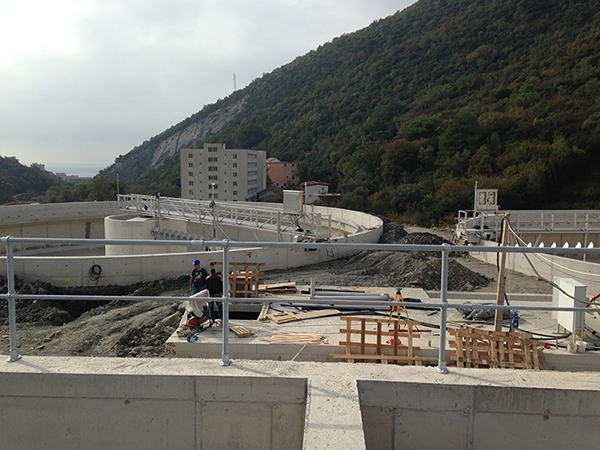
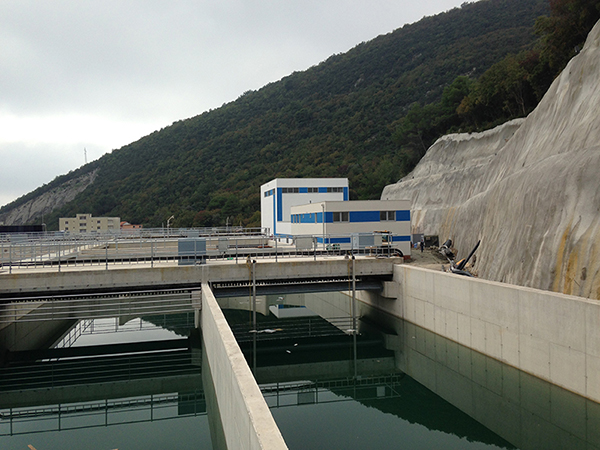
The Ministry of Sustainable Development and Tourism (MORT) replied CIN-CG that it had no information about illicit disposals of the sewage sludge in the rocky hinterland’s sinkholes. Cuca and Krivosija are areas with many crevices and pits and thus rumoured as waste disposal sites whereof the Ministry will “most certainly inform the inspectorate“.
The ministry reminds on regulations whereby “ the waste producers can either treat the waste autonomously or entrust the same to dealers or entities which gather or treat the waste“. Thus it is clear, according to the ministry, that the “businesses which operate wastewater facilities are obliged to take care of the waste“ .
The Budva City Council admits in its correspondence with CIN-CG that no waste treatment facility in Montenegro is technologically capable to process all of the waste. Hence the so called sludge treatment is not laid out. Instead, an arrangement was made in 2017 with the company of Florian Borsha to remove 4,100 tonnes of sludge to Albania at the cost of 64.5 €/tonne incl. VAT. Thus 264,441.80€ were paid last year. In 2018 another 6,000 tonnes will be carried off at the cost of 65.95 €/tonne (due to VAT increase) and 395,670€ in total.
On the other hand Budva’s city council has fought a long legal battle against the WTE Group in Germany which demands a payment of 58.5m€ for the wastewater plant construction as agreed in the contract. The local authorities refuse to pay for the phase 2 and 3 of the aforesaid project and claim that the construction hasn’t even been started, let alone completed. Dr Joze Duhovnik, a Slovenian expert hired by the Budva authorities claims in his extensive study that only 69.2% of the entire facility has been completed as laid out in the investment agreement. The project was meant to facilitate a wastewater treatment for a settlement of 130,000 inhabitants. However, the project is accompanied by corruption allegations (and is currently investigated) since one of the WTE managers reportedly admitted a payment of 3m€ to a person in the earlier local government whose name is withheld for the time being.
According to Duhovnik’s study only the central unit on Vjestica Hill has operational licence while ten pump stations are still in test mode. The project envisages the construction of wastewater treatment units in Buljarice and Petrovac and secondary sewage network. The piled up sewage sludge on Vjestica Hill is often a problem on rainy weather as it spreads out an unbearable stench down to the beach resorts and hotels.
The sludge from the joint Tivat-Kotor wastewater treatment facility was exported to Albania in accordance with the one year contract signed with the Montelea Co. The deal is nearly 40,000€ worth for the disposal of 500 tonnes. Anyway, it seems that not all 500t crossed the border as the customs records declare less than half of the amount. The water utility company in Tivat has no information as to what happened with the rest of the sludge and whether it was dumped somewhere outside of the facility.
The Montelea Company used to load the sludge near the Montepranzo Estate just opposite the Tivat Airport. First the sludge was dumped on the lawn and then encased in big containers which the Montelea’s lorries carried off to Albania. That was discovered in early October last year when the airport personnel and the passengers started complaining about the unbearable stench that was coming their way. After several days the airport’s security had enough of the stench no and took beyond the airport’s parametres. They discovered the mounds of sludge on the land of the Tivat Utility Services which thought it convenient to reload the sludge there for Albania shipments. The operation had to be aborted as it became public and awfully smelly.
The German WTE runs the joint Tivat-Kotor treatment facility since its opening in July 2016. The WTE Group and its daughter company in Budva had also constructed the same facility. The Germans were supposed to hand over the facility by 31 Aug to the joint Tivat-Kotor waste treatment company. Nevertheless the handover was delayed over the company’s registration procedure and the training of new staff (by the WTE Group). The cities reckon that the Germans are obliged to handle the sewage sludge discharged in the plant’s three reservoirs until the facility is handed over. Anyway, according to reliable sources, the disposal problem was ’solved’ a couple of times by direct discharge into the sea in the Bay of Traste since the ’reload station’ opposite the airport had to be shut down.
On one occasion a big dark stain was spotted in the sea from the nearby Lustica Bay high-end resort. The tourists made photos and reported it. Even the Montenegrin Environmental Protection Agency acknowledge that ’something strange’ was going on in terms of leakage from the more than 10m € worth facility. The executive of the joint Tivat-Kotor Wastewater Treatment Company and its only staff at the time, Srecko Tripovic wouldn’t talk to CIN-CG about the aforesaid problems.
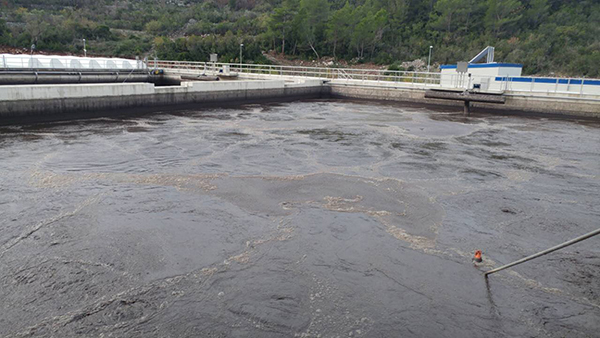
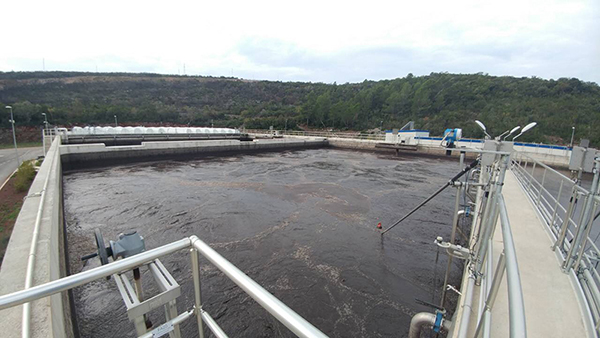
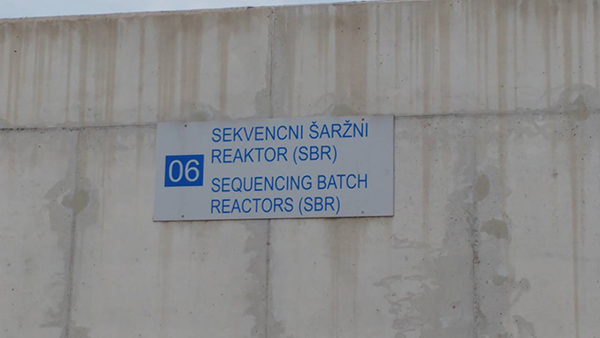
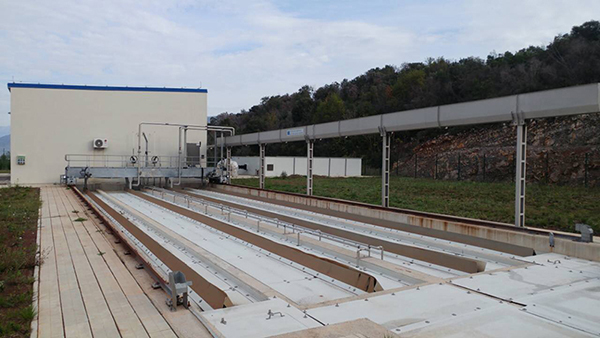
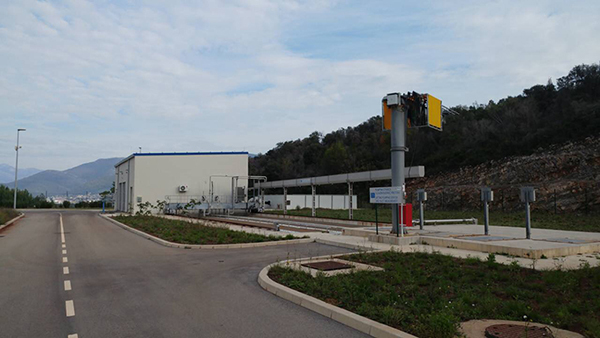
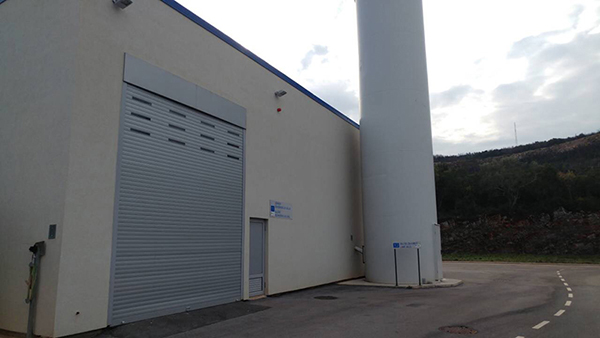
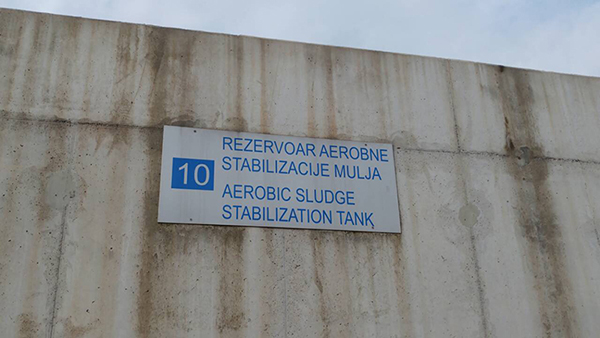
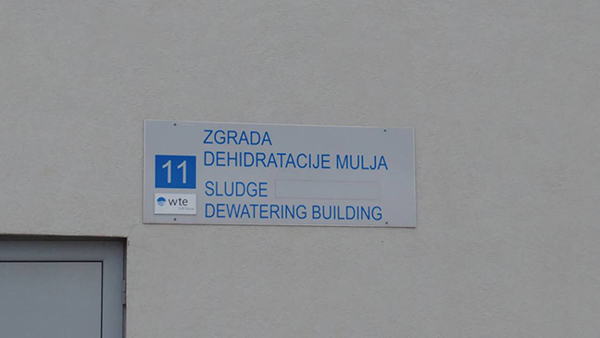
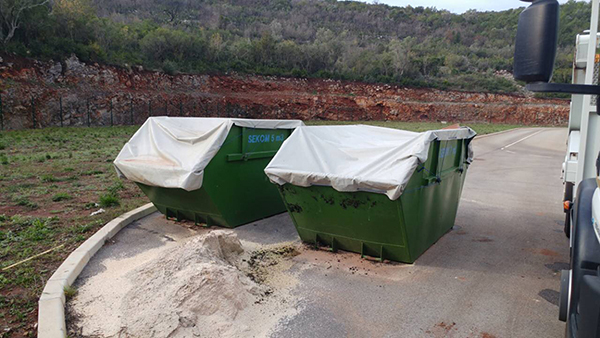
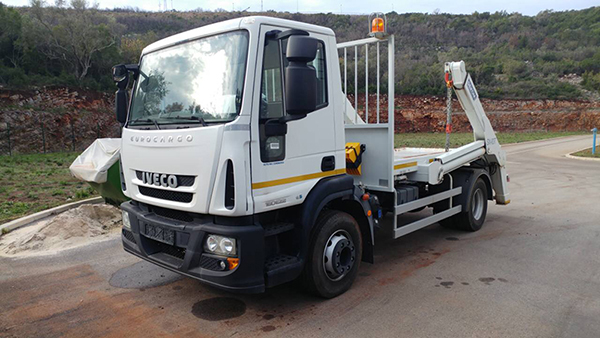
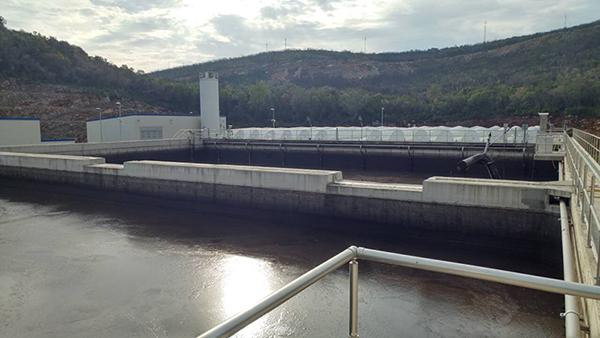
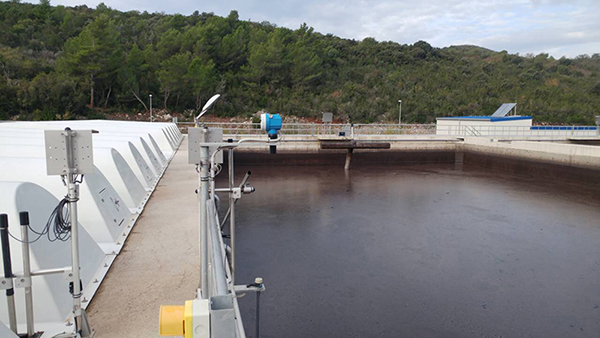
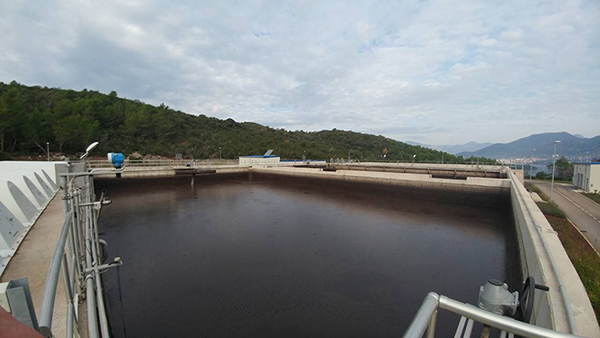
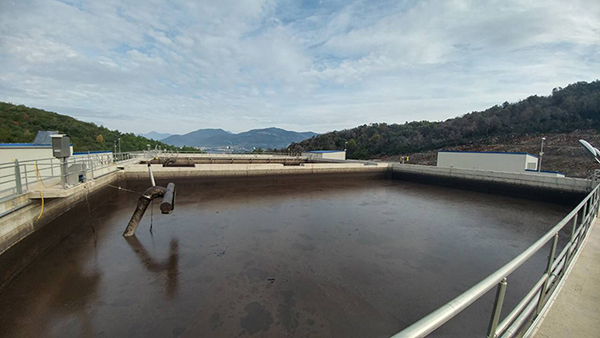
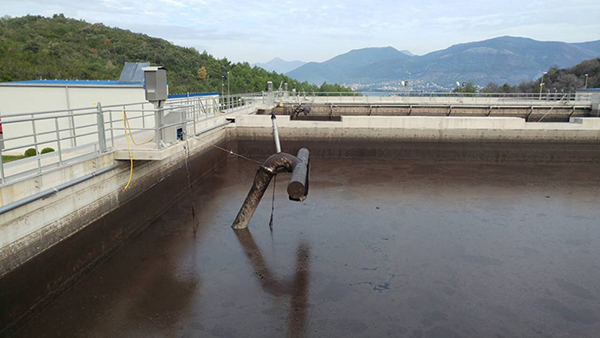
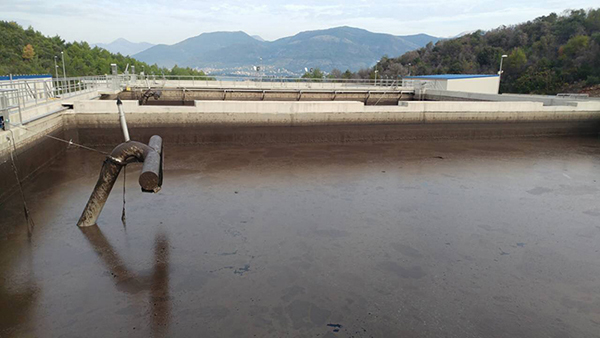
The WTE delivered two open top containers and a special carrier vehicle for the sludge transportation. However, the vehicle is still not in service as it lacks licence plates for some reason. Hence it cannot deliver the sludge to Vjestica Hill near Budva which is meant to be a hub for further shipments to Albania by another company. We are told, off the record though, that the Kotor Water Utility Services mulls a purchase of two special closed containers so they can successively drive off the accumulated sludge out of the facility in Krtola.
The Ministry of Sustainable Development and Tourism responds that Montenegro’s legislation is some 95% in harmony with the EU legislation and that a lot has been done to meet the Sea Coast Master Plan requirements in terms of wastewater treatment and drainage including the construction of 150km of sewage network and three waste treatment plants.
Montenegro’s northernmost coastal city of Herceg Novi is still without hassle with the sludge according to Jelena Djakonovic, acting head of the local water utility firm. The treatment facility in nearby Meljine is still in testing phase. The work on the sewers hasn’t been finished yet. The treatment plant in Herceg Novi is built by the Turkish MASS/Gintas consortium while another Turkish company- Celtikcioglu constructs the sewers.
The sustainable development ministry points out that the stabilised sewage sludge “is not harmful and can be used in agriculture after its proper treatment...it’s used in parks and other green areas, in re-cultivation of soil, foresting, as an insulation layer on the waste dumps and as renewable energy source through incineration...“.
Mojkovac treatment plant is appealed to as a good model copied from Denmark. Furthermore the Podgorica City Council planned a new plant with the thermal treatment of the sewage sludge. The German KfW Bank helped the case study for coastal municipalities where new and more advanced solutions will be implemented. The ministry further says that the law makes provisions for temporary sludge disposal in the interim period without giving us further details on what it means.
Experts are divided over the sewage sludge incineration because of air pollution and ash residue which thus becomes hazardous. Besides, the waste incineration is not popular in the EU. On the other hand, the local authorities have received a lot of bids from various companies and experts on how to solve the issue.
In the meantime “Vodacom” has developed an application model of the partly dried sludge from the Tivat-Kotor treatment plant which could be used to re-cultivate soil on two former waste dumps in Sinjarevo and Lovina. The investment will cost slightly over a million €. The KfW Bank would finance the project. The Tivat City Council endorsed it and now it awaits the same approval in Kotor.
National Customs Office- exports are legal
The Customs Office told CIN-CG that nearly 12 tonnes of the stabilised sludge (which can be used as a fertiliser) had been exported from Montenegro from early 2016 until Oct 2018.
“The Customs Office doesn’t keep export/import records for each municipality but it has them on the national level. The aforesaid material was exported to Albania indeed. Now pursuant to the law the information on particular physical and legal entities in the customs declarations cannot be shared without approval of all the parties involved“. The ministry further claims that such matter is in accordance with international regulations. As such it is not considered hazardous and thus has no export obstacles.
Siniša LUKOVIĆ
We know it all too well. The role of media in creating and disseminating lies and propaganda as tools for promoting and perpetuating conflict during the 1990s Yugoslav wars of secession is so well documented, that examples of it made it to the textbooks, documentary films, and courts in the Hague. According to Marija Šajkaš, a journalist and media analyst and advocate based in New York City, USA, that was also the time in which independent media in the region was thriving.
“As paradoxical, as this may sound, the period of the late 1980s and beginning of the 1990s is not only marked by the rise of Slobodan Milosevic in Serbia and his doppelgangers in other parts of the former Yugoslavia. This was also a time in which some media outlets were formed with the mission to promote freedom of expression,” said Šajkaš. She mentioned the fact that the first independent weekly in the country was Podgorica-based Monitor followed by Belgrade-based Vreme, both registered in 1990. “Since the days of their inception, articles in both outlets were against the war and in support of civil society values,” said Šajkaš, adding that the same principles guided Radio B-92 which was founded 1989.
Speaking at the lecture titled “In War & Peace: Development of Independent Reporting in Countries of Former Yugoslavia” at Columbia University's East Central European Center last week, Šajkaš said that independent media consistently challenged the war narratives and advanced, accurate reporting during the tragic Yugoslav conflict. For instance, Split-based Feral Tribune was the first to run a full-length investigative story about Croatian army plundering Serbian houses and stores after the operation “Storm.” Sarajevo-based Oslobodjenje and Dani were investigating the treatment of Serbs in the city while the siege was still ongoing. Podgorica based Monitor and Belgrade based Danas and Vreme were among the rare outlets in which people at that time could read about the role of the Yugoslav army in the sieges of Dubrovnik and Sarajevo, or about the actions of the Yugoslav army and paramilitary forces.
At the same time, the majority of the media in the war-torn country was manifestly obedient to nationalistic regimes. To understand the relative ease with which they slipped into disseminating fabrications and propaganda, Šajkaš argued about the importance of historical context and the fact that media outlets in the Socialistic Federative Republic of Yugoslavia were not free. “We were not encouraged to investigate wrongs or to act as watchdogs,” said Šajkaš whom herself made first media steps in Socialist Yugoslavia. “If anything, we were told that we are responsible for preserving and advancing socialist political system.”
The audience, mainly consisting out of professors, students and people who lived in Yugoslavia during the 1990s was also eager to discuss the present state of affairs. Professor Tanya Domi of School of International and Public Affairs at Columbia University who worked as a media expert in the region in the 1990s said that media situation in Serbia, Bosnia, and Montenegro today “Very much resembles the one during and immediately after the wars.” According to her, one of the main problems is prevailing tabloidization. Šajkaš said that the notion seems accurate, adding that nowadays we have set of the same problems and new words. “Today we say political spin instead of propaganda, and fake news instead of fabrications and lies. In essence, we are talking about the same thing. Unfortunately, we see these characteristics well beyond the Balkans.”
On Judiciary and Media Freedom in Montenegro
Brussels, 19.11.18
Dear Commissioner Hahn,
In the light of the 16th EU-Montenegro SAPC, which took place in Strasbourg from 14 - 15 November,
I as member of the European Parliamentary Delegation to Montenegro, hereby express my concerns
regarding media freedom in Montenegro. As Commissioner for regional policy and due to your active
engagement with the government of Montenegro, I want to draw your attention to the lack of media
freedom in Montenegro and the hostile environment for independent media in the country. Especially
due to the vital role of free media in democratic discourse, I call upon you, the Commission and all EU
agencies involved to work with our partners in Montenegro to improve the situation of journalists and
media freedom.
I want to draw your attention to three most urgent matters critical to maintain and improve media
freedom in Montenegro. First, guaranteeing prosecution of crimes against journalists. Second,
addressing government interference in journalistic activity and lastly the need to combat incitement
against journalists.
According to Freedom House as well as media freedom organizations, not a single case of attacks
against journalist and the media have been solved since 2004. Reportedly 76 cases remain unsolved
including attacks with explosive devices against journalists and offices of independent media
organizations. The lack of justice and protection for free and independent media in Montenegro is
cause for great concern and must be addressed with utmost urgency and determination. Therefore I
strongly urge you as Commissioner to work with our partners to ensure a safe environment for media
and democracy to strive in Montenegro.
I welcome the Commission’s statement in its staff working document from April this year addressing
the situation of the public broadcaster RTCG. However, the Commission must insist that all
government institutions in Montenegro regulate their financial support for broadcasters in a
transparent matter in order to curb attempts to influence editorial policy across the full spectrum of
media organizations in Montenegro. This includes legal interventions against contracts between
institutions and certain media to curb state influence on the media market. In order to ensure media
freedom in Montenegro and to support transparency and accountability of public institutions, the
Commission must insist on addressing the structural challenges to media freedom in Montenegro.
Lastly, I want to draw your attention to the repeated incitement of Montenegro’s president, Mr,
Djucanovic. Due to his vicious, derogatory treatment of the media he contributes to the environment
that allows for the attacks and systematic pressure on independent journalism in the country.
Therefore I urge you to take political measures in order to stop this incitement from happening in
order to ensure free media for a functioning democracy in a future part of the European Union.
Yours sincerely,
Things have got worse since the government imposed moratorium on gravel extraction and the so called strict control of riverbeds. Sharks in the construction business make millions in dredging the Moraca River. On the other hand, the treasury of Podgorica City Council benefited fewer then four Euros from the concession fees in 2016.
The bank of the Moraca River in the village of Botun near the Podgorica Aluminum Plant (KAP) looks as though struck by the Apocalypse. The scenery resembles a science fiction doomsday movie. The river thereat has lost its unique appeal and all the rocks and caves that had dotted the bank have been turned into huge piles of trash and construction waste.
The Celebic Company as well as others line up the river bank amidst mounds of sand and gravel which block and dwarf the river. Gravel is spilled around for miles. You can see it on farm lands, on the pavements, etc. It was Sunday when we toured the area. Each hundred metres we saw heavy machinery and dredgers which drilled through the riverbed and juggernauts driving the loads away despite the government moratorium on sand and gravel extraction.
The gravel ban hasn’t improved the things. Montenegro’s riverbeds have become unrecognizable by havoc wreaked while their living world is on the brink of obliteration. The business is conducted under pretense of watercourse regulation which makes certain individuals and companies filthy rich while the whole community is expected to foot the bill for immeasurable environmental and economic destruction- as the Montenegrin Investigative Reporting Centre (CIN-CG) and the weekly Monitor find out.
The minister of agriculture Milutin Simovic admitted that "the rivers were destroyed and that strict monitoring would be enforced". Moreover he warned those who act in defiance of the government and said that they would have to face the consequences. However the business continues as usual. No more than three inspectors are assigned to control the major rivers and their tributaries while the paltry fines are no deterrent to lawless behaviour. Furthermore, the ongoing criminal activities and alarm bells from individuals and NGOs cause no concern to public prosecutors who wouldn’t even bother to take a look, let alone launch an investigation.
Directorate for Water told CIN-CG/Monitor that "the Ministry of Agriculture and Rural Development introduced the moratorium due to expired concession contracts and illicit extractions... and also because of needed watercourse regulation projects".
The National Sustainable Development Council that monitors the issue was "pleased with the progress" of the moratorium and the watercourse regulation drafts. However, the same apocalyptic Moraca landscape can also be seen in the river basins of Tara, Cijevna, Lim and other rivers whereof the National Council can be "pleased with the progress".
Watercourse regulation as excuse to carry on as before
Gravel extraction contracts for 25 locations (the rivers of Moraca, Lim, Tara, Ibar, Grncar and Gracanica) expired all by the end of 2016. The Ministry of Agriculture claimed that riverbeds and the living world therein had to be revitalised of which the fish habitats and the water quality improvement were the prime targets. Nonetheless, the Ministry failed to respond whether any of the concessionaires have restored the areas that they had exploited. The example of the Moraca River is notorious as the licensee left two big craters near the river bank which now serve for garbage disposal.
Aleksandar Perovic of the Ozon Environmental Movement (OEM) said to CIN-CG/Monitor that it would be hard to find a single concessionaire void of avarice and arrogance. "All they want is more profit".
The privileged circles push for merciless exploitation of natural resources whereby they make millions through the aforesaid operations. At the same time they destroy ecology of the riverbeds and pay miserable money to the state treasury and the city councils. Already back in 2014 the Parliament’s Committee on Economy, Finance and Budget unanimously agreed that the field of concessions (including watercourses) was unregulated and that the treasury could have collected more than €10 million out of it. The state revenue from concession licences amounted to dismal € 25,217.76 in 2016, when the extractions were still legal.
However, the licencees didn’t even bother to pay that meagre amount and hence many local governments didn’t even get the crumbs of the crumbs that they were entitled to (70% of the concession fees were to be allotted to the city councils and the rest to the state treasury). In reality, the Podgorica City Council had a revenue of €3.91 for gravel extraction back in 2016.
The residents of Botun that CIN-CG/Monitor reached out to would not speak on record. But they informally admitted that the moratorium did not bring any improvement. The gravel is still extracted, poison is all around, the fish stock is gone and the beaches along the river are destroyed.
Believe it or not, the ongoing environmental disaster has become even more complex. A part of the population ferociously protests while the other part is indignant because they are barred from taking their own turn in the dredging. In a recent gathering in Botun they even threatened to block the roads and become more radical if the government remained deaf to their demands to join the extra(destru)ction efforts. Upon the protest the Directorate for Water replied that the aforesaid area is under the water regulation project (with three contractors and the monitoring team). The aim thereof is not to exploit but regulate the course of the Moraca River while all the extracted material is recorded and paid for accordingly. The excess material is paid by the contractors Cijevna Komerc – 2,75 €/m3, Beton Montenegro – 2,76 €/m3 and Bemax 2,78 €/m3
Mr Perovic (OEM) retorts that "the Government and the Ministry of Agriculture made a joke of the moratorium from the onset as they allow the extractions under pretense of the so called riverbed regulation which is granted to the privileged only. That breeds corruption and other illicit activities which should alert the public prosecutors’. He adds that the Gracanica River in Niksic is actually the worst example and its "riverbed is actually a flowing waste depot".
Profit multiplied by six
Milutin Micovic, president of the Lim Fishing Club in Berane says that the moratorium did work there for a couple of months in 2017 due to alarms in media and inspections on spot. Nevertheless "in 2018 the lucrative dredging has resumed without restraint under pretense of restoration and regulation".
Micovic explains that those in the business got two permits after years of merciless destruction of the river ecosystem. One permit allows for removal of the Lim gravel-bars and sandbars in seven locations along with construction of an embankment on a line of the river. The other permit allows the contractors to carry away the sifted gravel and pay €3.05/m3 compensation to the government.
Bigger "concessionaires" were granted permits for three locations in the Berane Municipality to conduct the so called watercourse regulation which includes embankment although there was no need for that- says Micovic. Thus they’ve managed to dredge away hundreds of thousands of cubic metres of sand and gravel.
The Directorate for Water told us that the Beton Group – Popovic Ltd, was issued permit to carry out "emergency works" in the Lim riverbed in Berane’s urban area in the length of 500m.
Damir Gutic, head of the Directorate for Water told CIN-CG/Monitor that despite the moratorium some permits were granted pursuant to the regulations for the purpose of watercourse regulation so to prevent sandbars, meandering, erosion of arable land and flooding. He further says that since the moratorium the Directorate issued approvals for emergency measures in 6 municipalities on the rivers of Grncar, Lim, Tara and Moraca.
"The emergency measures" are carried out by 13 companies (see the table) as the water directorate states. It appears that all is about (tonnes of) money. The cubic metre of extracted gravel is paid €3.05 while the market price is as six times as much. In the last year, when the moratorium was introduced, the "contractors" officially dug up 26,847 m3. The official data does not corroborate with the allegations of the locals protesters in Zeta (the Moraca basin) who publicly stated that "just one of those concessionaires extracted 70,000 m3 claiming it was approved by the capital city’s council". The locals that we spoke to say that they had referred to the Celebic Company which was entrusted with the job of eliminating the sandbar and accumulated material in the location of Misurica (the length thereof is 300 metres).
Upon complaints of the Zeta locals that the gravel extraction continues unhindered, the authorities set up an overseeing committee. Nonetheless the city authorities wouldn’t respond to our inquires about the findings of the aforesaid committee. The Celebic Company also remained silent to our question whether the sandbar removal license has been renewed this year. The Bemaks and the Cijevna Komerc wouldn’t answer the allegations about ongoing gravel extractions.
Directorate for Water told us that this year 23 watercourse regulation contracts had been signed but we didn’t got the list of companies that were to carry out the projects. The Directorate still has no complete data on the extracted amounts in 2018 and no evaluations of paid concession fees- so we are told by director Gutic.
Mr Micovic explains to us what the regulation means on the ground. "Directorate for Water approved the removal of a part of the bank around the bridge in the centre of Berane where Fly Fishing European Championship will take place in 2019. There was no concern about dredging around the bridge even though the law forbids every undertaking in the length of 100 metres around it".
Moreover, the licences issued to two companies to carry the work on a part of the Lim River account for another big problem. The Ljesnica River, which is the Lim tributary, is natural fish spawning ground and has been been protected under strict law over the last 20 years. "Over there you have true ecocide as the Lim has been moved to the left towards the village of Stitari in the length of a thousand metres and thereby separated from the Ljesnica which is walled off so that heavy machinery can dredge the hundreds of thousands of cubic metres unhindered“ points out Micovic.
Authorities "concerned" again
After the introduction of the moratorium, the government formed the Coordinating Team (CT) and drafted the action plan to no avail. The CT is made of representatives from the government and the local authorities who now jointly warn (again) that every illicit extraction will be duly punished. Inspectors recently monitored the Moraca riverbed and concluded that "there are reasons for concern due to a number of illicit extractions. Furthermore, erosion of soil and arable land near the river has spun out of control".
Jovana Janjusevic is executive of the Centre for Protection and Observation of Birds which is a local NGO. In her interview with CIN-CG/Monitor she claims that the best thing would be to give up on those watercourse regulation projects as "rivers are natural ecosystems and the best way to keep them pristine is to spare them from human interventions as it was the case for thousands of years before". She reminds that all over the EU there are ongoing projects of restoring riverbeds to where they were in the first place.
Micovic emphasizes that there’s hardly any control of the rivers and says that "while the Directorate for Water is in charge to issue licences, it's up to the inspectors to monitor the work. However there is only one inspector in the northern half of the country".
Experts who work for the government told CIN-CG/Monitor, on condition of staying anonymous, that the government could easily solve the problem if it wanted to- hire more inspectors who will be assisted by police and set up road blocks on exit ways, control the lorries and the amounts of extracted sand and gravel that are driven away. Nonetheless, those who have sucked millions of Euros out of the rivers are close to the government and such synergy only makes things worse. The Ministry of Interior is also involved as it fails to control the gravel transports despite the fact that many lorries operate without proper plates and permits.
When it comes to the moratorium efficiency the real icing of the cake came from the government which permitted the Chinese CRBC to extract gravel in close proximity of the Tara River source. This UNESCO protected river is also on the path to destruction under pretense of watercourse regulation.
Minuscule fines
Inspectorate General issued 13 fines for various irregularities since the moratorium introduction (against 11 individuals and two legal entities). The total sum of fines is €4,800.
Directorate for Water can’t boast of the moratorium enforcement either. It provided toll free telephone line to report illicit extraction as well as email address. So far 31 reports came through which were forwarded to the inspectors. On the other hand, Directorate for Water announces amendments to the law which regulates the matter and more severe penalties.
Predrag NIKOLIĆ
Dear Commissioner Hahn,
Hereby we write to you upon our brief encounter with the RSF Balkans bureau chief at the EU-Western
Balkans Media Days 2018 in Skopje last month. We continue to be gravely concerned with the media
situation in Montenegro and the sheer impunity for attacks on journalists, whether by words or physical
force.
Apart from economic pressures, smear campaign and threats we believe that the foremost obstacle to
any improvement in this field is the judiciary in Montenegro which acts with unaccountability and
impunity. In many cases the judiciary rather follows the ruling party’s orders and guidelines than the
letter of the law. This is very visible whenever President Djukanovic gives derogatory statements against
independent (and critical) media calling them “fascists”, “traitors”, “extortioners”, “mafia” etc. Upon
such incentives the judiciary swiftly reacts. This is the main reason why not a single case of violence
against journalists has been fully resolved since the murder of the daily Dan's editor in chief Dusko
Jovanovic in 2004. Consequently the media freedoms have been on steady decline as the rule of law is
wanting in Montenegro.
Here are just a few examples of judicial partiality:
- The case of investigative journalist Jovo Martinovic (among others awards, the winner of 2018 Peter
Mackler Award for courageous and ethical journalism and co-winner of DuPont-Columbia Gold Baton of
2001) who spent nearly 15 months in pre-trial detention under dubious charges that he was actually
reporting about. Upon his release in early Jan 2017 his traveling abroad is restricted and his trial has no
end in sight after three years. In spite of clear evidence that Martinovic was just doing journalistic
investigation for his French production the outcome is uncertain as he and his family and friends were
under the prosecutors’ pressure to sign false confession in exchange for release.
- The case of Olivera Lakic (a well known investigative journalist of the daily Vijesti) who was shot in the
leg on May 8, 2018. No progress has been made in the investigation. That was second attack on Lakic.
She has reported for years on senior Montenegrin officials' links to cigarette smuggling rings. The first
attack, which has remained unresolved, took place in 2012, after a series of her articles on illegal
activities in a tobacco factory in Montenegro. Veselin Veljovic, the then National Police director was
referred to as being privy to the attack. Veselin Veljovic was replaced thereupon, but was re-appointed
in July this year, despite all the controversies. President Djukanovic publicly stated recently that “it's
normal” that the judiciary hasn't solved the case yet. He further said that Olivera's wound was
“controlled damage“ so to blow off the authorities that he represents. The pro-government media run a
permanent campaign against Lakic and the Vijesti and suspect them of having staged the attack.Besides,
there are 20 other cases which remain unsolved where journalists were physically attacked. Dusko
Jovanovic was killed; Tufik Softic was ambushed and heavily beaten up, subsequently a hand grenade
landed in his house yard; Zeljko Ivanovic was ambushed and beaten up with metal rods; Mladen
Stojovic fared the same; the premises of daily Vijesti were bombed; Vladimir Otasevic received death
threats etc.
- The case of Milka Tadic Mijovic and Milena Korac Perovic (winners of several awards, Tadic Mijovic
being on the Reporters Without Borders' first ever list of the 100 Information Heroes), the plaintiffs
against the Daily Pobjeda and the state. In August 2018 the Podgorica District Court ruled against the
libel charges of the aforesaid journalists after six years of trial and four judges replaced in-between.
Tadic and Korac were subjected to smear campaign by Pobjeda, the government controlled daily. Some
50 articles were published in 2011-2013 wherein they were repeatedly called "scum", "the whores in
trousers”, "sluts", "good pussy" and threatened as “thugs deserving the graveyard“, “they will get a kick
in the buttock“, “eventually get beaten up“ etc.). The Podgorica District Court rejected the lawsuit on
the basis that the plaintiffs were public figures and that “Pobjeda articles contributed to public debate“.
The plaintiffs were ordered to pay nearly 3,000€ of court expenses. Tadic had previously sued the E
Novine in Serbia on similar charges and won the case in 2015 (some of the E Novine texts were actually
reprints from Pobjeda). The Serbian court ordered the E Novine to pay libel damages, the highest in
Serbia since the fall of Milosevic. On the other hand, Montenegro's courts awarded Djukanovic, his
family members and friends altogether 300,000€ in libel damages upon their charges against Vijesti,
Dan, and Monitor for their investigative articles.
- The ousting of RTCG (national public broadcaster) management: The top managers were removed
despite concerns and objections from the EU, the US and international organisations. The ruling party
controlled RTCG Council sacked its head manager Andriana Kadija on 8 July 2018. Kadija had initiated
reforms and distanced the news program from the ruling party guidelines. Her firing was carefully
prepared and preceded by illegal replacement of the reform minded civil sector representatives in the
Council. Although the courts ruled that some of these removals were unlawful, the new Council
members took their seats including senior officials of the ruling DPS party. Bozidar Sundic, known for
close ties to the regime, was made the new general manager.
Dear Mr Commissioner, we believe that these examples show that Montenegro's citizens are not equal
before the law. Progress in the freedom of media, democracy and the overall EU integration of
Montenegro is impossible without the rule of law. Hence we urge you to press Montenegro's authorities
towards genuine judiciary reform without which the rule of law will remain a cliché.

